
Map with complete track
Private homepage – Hans-Georg Michna
Kenya travel reports: 1999, 2000, 2002, 2003, 2004, 2005, 2006, 2007, 2008, 2009, 2010, 2011, 2012, 2013-Goma, 2013, 2014, 2015, 2016, 2017, 2018, 2019
Kenya Safari Travel Plan, Kenya 1980-2000 photos
Kenya 2016
A personal travel report from Kenya in May 2016
Last change: 2016-06-28 – Copyright © 2016-2023 Hans-Georg Michna
Click on the small pictures to see them enlarged, usually to 800 x 600 pixels.
Times are given in local Kenyan time in 24 h format (without "am" or "pm"), i.e. 0:00 to 23:59.
All photos are subject to copyright ©. If you want to reuse any photo, send me an email asking for permission, and I may send you the full-size photo, usually 3,264 x 2,448 pixels (8 Megapixels). These photos bear the copyright © 2016-2023 Hans-Georg Michna.
EXIF times in these pictures should carry proper time and time zone information. Kenya time is UTC + 3 h.
[I use my latest camera—a Fujifilm HS50EXR. Most photographs in this travel report are reduced to 800 x 600 pixels and JPEG-compressed with medium strength to make them more palatable for the web.]
My Kenyan phone number, active in May and June this year while I was in Kenya, was +254724662096, but is now disabled. It was good for SMS and calls, but the better ways to reach me are Hangouts, Telegram, Threema, WhatsApp, Skype, and email. I think, for those chats that use telephone numbers as addresses, you may have to use my German mobile number +491793217777.
My travelling checklist in michna.com/kenya.htm#Preparations (German version: michna.com/kenia.htm#Reisevorbereitungen) is, as always, my means of packing without fear of forgetting anything important. As usual, the packing and other preparations take at least a full day of concentrated work, because they cover an immense number of small things and details. Without the checklist I'd be lost.
KLM, Air France, and Kenya Airways on their flights to Nairobi currently allow two pieces of check-in luggage of up to 23 kg each in the economy class. KLM also has a pretty good and informative web site and a reasonably good smartphone app (click here for the Android version if you fly KLM), allowing ticket purchase, online check-in, and seat selection, now also for the flights operated by Kenya Airways and Air France. This worked reasonably well, with a few quirks like this: I could change our seats after printing the boarding pass, so the boarding pass had the wrong seat numbers. But the airline did not resend the mobile boarding pass after the change, so I had to use other ways to find and print it, which leads to a different-looking boarding pass. But it worked.
The late and heavy rains in Kenya were worrying me, mainly because of getting stuck on muddy tracks. Nairobi has had floods and some deaths because of a collapsed building that was not built properly and could not take the torrential rains. Other areas also got lots of rain. Even in Marigat (near Baringo), where it sometimes does not rain for three years, a river broke its banks and flooded the town. In a few weeks we will drive through there.
But we received some good news on the weather a few days before our departure. Masai Mara, our first destination, has had three wonderfully sunny days. The "black cotton" soil there is tricky. Even light rain turns it into a very slippery surface that is difficult to navigate by car. But some hours of sunshine already dry out the surface and make it drivable.
I will meet friends and bring them smartphones. Article in German language about current smartphone choices
The alarm clock, actually the smartphone, rang at 4:00, and we, my wife "Mausi" and I, reached Munich Airport around 5:30, in time for the 7:15 departure to Paris Charles de Gaulle Airport (CDG).
The flight to Paris was uneventful and timely, which was good, because we had only 2 hours to change planes. In the past this would have been plenty, but times have got worse.
I do not like the Paris Charles de Gaulle airport much. It is much less efficient than Amsterdam Schiphol. Indeed we had to stand in a huge line for a passport check for about one hour.
After that and a bus ride all around the huge terminal 2 we reached the gate for our next flight, and boarding had already begun.
An odd detail is that I had printed our boarding passes at home on normal A4-sized paper, and it now turned out that the optical codes were too big for the gate machines to read. So we pulled out our smartphones and used them to present our boarding passes, which worked fine. Note for next flight: print them smaller.
The airplane was a Boeing 787 "Dreamliner", operated by Kenya Airways, and this turned out to be a really nice plane. The entertainment system had relatively big screens and a very good collection of over 100 movies, most of them new. The windows no longer have mechanical covers. Instead they can be dimmed and brightened in several steps by means of LCD technology.
The downside to this is that the GPS absolutely does not work. I could not receive a single GPS satellite, so the joy of knowing where I fly no longer exists, and I have no record of the track.
The plane flew on an easterly route via Khartoum, so we could see the Nile valley for a while. But during most of the flight we could not see much, because it was cloudy or dusty.
So I unpacked my noise-cancelling pilot headset and the matching adapter and watched a whole batch of movies. Whenever I decided that I liked the movie, I made a note and jumped to the next. The good movies will be watched later in the home cinema. I went through more than half a dozen movies that way.
Using the Kenyan mobile payment system M-PESA, we had already loaded our Kenyan prepaid SIM cards with data packets on the day before our departure. We now removed the German SIM cards from our smartphones and inserted the Kenyan ones, so we would have full connectivity immediately after landing. This worked flawlessly.
Evenually the sun set and it quickly got dark. Flying into Nairobi is always impressive. After flying over mostly dark areas the lights of the Nairobi outskirts appeared below and finally the city. We landed on time.
The airport had changed again and now presents itself in its final form after a fire had destroyed much of the terminal. Last year it operated on a provisional basis, now the new building has been completed, and it works well.
I still do not understand why there were only so few people around us, so passing the immigration and visa counter took only little time. I have no idea where the hundreds of passengers of our flight had disappeared to.
Within reasonable time all four pieces of our luggage showed up on the conveyor belt, and we had to go through customs. I was worrying a bit about being considered a smuggler, because we had a number of used smartphones in our luggage, but the customs lady only asked us friendly whether we were here on business. After determining that we are tourists, she waved us through with a smile, and we were out of the building in no time. Our friends will be grateful for the smartphones.
The car hire company, Concorde Carhire, had promised to send their driver to collect us and take us to the Aero Club, but he was not there. So we had to communicate a bit to find out his mobile number and call him. It turned out that terminal 2 has multiple similar exits, and he was waiting at a different one. Note for the next flight: We should make it easier and just take a taxi, which has a standard price of KSh2,000 ($20) for rides from the airport into the city.
Our first destination after landing in Nairobi was, as always, the Aero Club of East Africa on Wilson Airport, where the askari (watchman) had our room key. Before going to bed we visited the bar, greeted all the people who know us, and had a drink.
Initially we had planned to stay in Nairobi only for two days, but it soon turned out that we had no chance to do everything we wanted or had to do in two days. So we extended our stay here by one day and stayed until Wednesday, the 18th. The Aero Club of East Africa is a nice, relaxing place, so the only downside was one day less out in the bush.
I had a few interesting experiences with the banking system and with the Kenya Civil Aviation Authority. It turned out that the banking system worked better than expected, while the government services worked so poorly that we may have to give up our plans to fly in Kenya.
M-PESA is interconnected with bank accounts and ATMs, so I have very many ways of getting cash, in spite of the fact that we hardly need any, because we can pay nearly everything directly through M-PESA. Since we had only little cash left over from last year and did not yet know the many ways to obtain cash, we paid everything through M-PESA, except tips.
Another interesting thing is that this time, for the first time, we finance our entire time in Kenya exclusively with bitcoins and mostly without banks. There are about 20 bitcoin dealers in Kenya, who accept bitcoins, usually through LocalBitoins.com, change them to Kenya Shillings, and put these into my M-PESA account. This takes only a few minutes, so it is convenient in spite of some M-PESA limitations (max. transaction KSh70,000, max transactions per day KSh140,000, max. amount in any one M-PESA account KSh100,000). So while Mausi had her SIM card replaced with a new LTE-capable one, she also got her own M-PESA account, which effectively doubles our payment limits.
You can get cash from any bank or M-PESA agent, of which there are many in Kenya, but you can also withdraw cash from most ATMs here. The procedure is as follows.
M-PESA is also interlinked with bank accounts, so Kenyans can withdraw or deposit money through M-PESA. One can learn some interesting things in Kenya, which is at the forefront of certain financial technologies.
Yesterday it was dry, but it rained throughout the night and was still raining in the morning. I pondered the thought of giving up on Masai Mara this year, but decided to give it a try anyway.
We had breakfast at 6:30 and drove out of the Aero Club of East Africa at 7:00. The new Southern Bypass road took us out of Nairobi in no time, and soon we were on the freeway towards Nakuru, driving in continuous rain.
We turned off towards Mai Mahiu, dove into the Rift Valley, reached Mai Mahiu, and branched left to cross the Rift Valley in westerly direction. Down in the valley it gradually stopped raining.
The Great Rift Valley is about 50 to 80 km wide here, depending on where you define the edges. The road leads over the foot of the Mt. Suswa volcano, next to a new geothermal power plant, then steeply up and out of the valley. Much of the area is farm land, but there are still some zebras, Thomson's and Grant's gazelles, impala, and wildebeest.
We reached Narok, a Maasai city, already at 10:00, bought a little bit to eat and filled our tank. Then we drove on.
Our plan was to drive the same route we had used last year, along the the paved B3 road, branching into the C13 road, actually an unpaved gravel track, via Lemek, and turning south near Aitong onto the C14 that leads to Talek Gate.
The road/track was as expected, only less dusty because of recent rains. Already on the way to Lemek we had to pass a few rather deep water holes, one of which was difficult to pass.
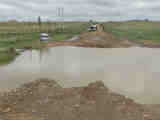
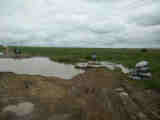
Water hole before passing; after passing
We watched one car going through this hole, but it was too deep for us. I was afraid the engine would suck in water instead of air. After some thinking I drove around it on the side where Mausi stands in the second picture, with the right wheels on firm ground on the little island behind Mausi, with a little speed and momentum. Note that the second picture was taken looking back after passing.
That method of crossing was observed and quickly made the rounds, so more drivers used it. Later people recommended it to me.
After turning into the C14 near Aitong and passing Aitong, however, there was a large gathering of motorcycles and a few cars in front of a 10-meter-wide river that crossed and cut off the road. Judging from a man who bathed in the river, the water was a meter deep, so that we had no chance of crossing. We had to turn back towards Narok and cross the two difficult water holes again.
After a while I noticed that one wheel felt strange, so I stopped and jumped out of the car. Sure enough, one tire, the rear right one, was almost completely flat.
We are good at changing tires due to the rigorous training in Africa. But we immediately ran into unexpected problems. The first was that the spare wheel was attached to the rear door and locked, but we could not unlock it, because the lock did not work as expected.
After various attempts to open the lock I finally succeeded. The lock works in a very unusual and probably insecure way.
Then the vehicle jack turned out to go bad as we lifted the car. It became ever more difficult to turn, and we could barely raise the car high enough to remove the wheel.
We tried to mount the spare wheel, but its bigger radius and a stone in the ground made that impossible. A man walked by and offered to help. He said he was very strong, which indeed he was. He kept turning the crank until the car was lifted high enough, but the crank bent out of shape, and we were later completely unable to turn the crank on that jack at all, in any direction. Nonetheless we were grateful, because we could now drive on and reach Narok.
We reached Narok at 18:00, half an hour before sunset, and had already decided that looking for a good hotel had the highest priority. Thanks to Google Maps we quickly found the possibly second-best hotel of Narok, the Seasons, and checked in. It was not up to world standards and somewhat overpriced, but it was sufficient for our purposes. The best one would have been too expensive for us.
After unloading our luggage, I jumped into the car again and drove to the Shell petrol station in the center of the city and asked there for help. But my attempts were largely unsuccessful and the services overpriced. I did, however, get the tire repaired and walked through Narok at night in search of a matching jack.
After returning to the hotel from my nightly runaround, I took a late dinner in the hotel restaurant and then went to bed. It began to rain again and rained throughout the night.
The next morning, while it still rained, we took the hotel breakfast, loaded our car and drove back to the Shell petrol station again, where I found a helpful Shell employee. He rechecked the repaired tire, pumped up our spare wheel, and drove with me to a city quarter where the narrow, very muddy, and partly flooded streets are lined with car part shops. We found a suitable jack, I bought it, and we returned to the petrol station. Now we could finally change wheels again, which we did.
We still had another technical problem. The electical window on the driver's side got stuck when it was dry. When the glass was moist from rain, it worked well, but as soon as it was completely dried out, it sometimes got stuck half way, such that I was unable to open or close it completely.
So I asked the helpful Shell man for a car mechanic for such a problem, and he offered to find one for me. The mechanic came and proved to be knowledgeable and diligent. He took the door apart, adjusted the window rails and lubricated them. This was also a full success so far.
Finally we drove out of Narok towards Masai Mara for the second time, on the main road and gravel track to Sekenani Gate. The road was terribly bad, as it had been in recent years, and we barely managed an average speed of some 25 km/h. This road had recently been redone, but it was done so badly that a few rainy months had already destroyed it to a degree that drivers drove next to it wherever possible, an interesting example of value-subtracted, rather than value-added.
We reached Sekenani Gate before 15:00 and had previously decided that we would, in this case, continue to Fig Tree Camp. We would have tried the AA-Lodge before the gate, if we had not reached the gate by 16:00.
After paying the entrance fee, we finally entered Masai Mara and enjoyed the wonderful view of the grass savannah landscape with its exotic and beautiful animals. Among many others we saw three hyaenas.
Around 16:30 we rolled onto the parking lot of the Fig Tree Tented Camp and crossed Talek River over its pedestrians bridge. We were greeted by a few lodge employees who all still knew us.
After resting a little in our nice tent we had dinner in the open-air dining room. After the good dinner and a short stint at the fireplace we went to bed, but not before writing this travel report.
We drove out in the morning and moved roughly parallel to Talek River in the upstream direction. Some areas were still wet and muddy from recent rains. We had to turn back at one point, and some crossings were marginal. One I would not have crossed, had I not seen a two-wheel-drive tourist minibus cross first.
We were rewarded with the view of many interesting animals, elephants, various antelopes and gazelles, buffalos, and a male and three female lions. They were a bit too far away for good photographs, so please bear with me until I insert the first photographs here.
After lunch we exited the Masai Mara nature reserve through Talek Gate and drove into Fig Tree Camp from the other side. The camp is actually outside the reserve, Talek River being its border.
I had the tire pressure adjusted, because I correctly suspected that it was off the mark. The freshly repaired tire had a far too high pressure, all others were somewhat low. And I had the car cleaned, because it was so dirty that you could not read the registration sign.
In the late afternoon I drove out to look for animals on the northern side of Talek River, downstream. I saw quite a few animals, particularly a large group of giraffes, before returning to the camp 15 min before sunset. A nice dinner rounded out the day, and I continued to write this travel report while listening to the hippos next to our tent in the river.
We hear them throughout the night. It is a difficult decision whether to apply earplugs. With them I sleep a little bit better, but I would miss so much of the African sounds of the night. I slept without last night and will probably again not use them tonight.
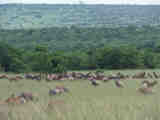
Many topis gather near the river.
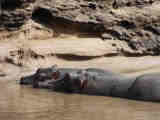

These hippos sunbathed directly in front of our tent.
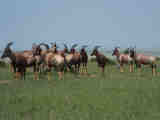

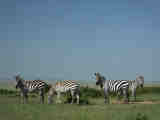
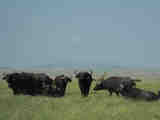
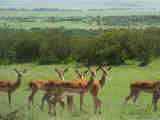
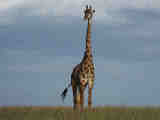
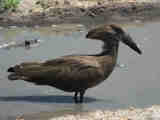
Topi; eland; zebra; buffalo; impala (females); Maasai giraffe; hammerkop
Today we had a lot of sunshine and good light for photography. Some results:
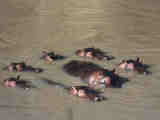
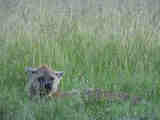
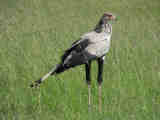
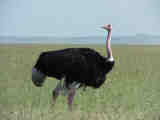
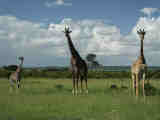
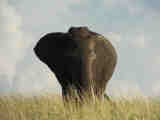
Hippos; hyaena; secretary bird; ostrich; giraffe "family"; elephant
Giraffes do not live in families. The bull may have been the kid's father, but most likely it was just another giraffe bull who happened to be here.
Some elephant safari photos follow.
These elephants established a new record. The matriarch approached our car and passed behind it at a distance of one meter (3 ft). Even the Amboseli elephants that are very used to tourist cars usually keep a 2 m distance.
Why did I not drive away to avoid such close contact? Female elephants are usually very gentle when they do not feel threatened. If this elephant had had any misgivings about us and our car, she would have stopped grazing, spread her ears, shaken her head or even trumpeted. But she slowly walked to our car while feeding and showed not the slightest sign of discontent.
The thought occurred to me that she might touch the car with her tusk to check whether it was hard or soft or to see what we would do if she pushed us a little, but in the event she didn't. If she had touched the car, she might have done it with her trunk, not her tusks, but to the best of my knowledge elephant cows don't do that in a calm situation like this.
The whole afternoon consisted of watching the camp crew tow a dead hippo bull out of the river and away from the camp, because of the smell. I lost count of how often the rope tore, but just before sunset they finally managed to tow the dead animal far enough into the bush. I expected the hyaenas to eat it at night.
Before this, in the morning, I had driven around a little and taken some documentary photographs of the most prevalent ungulates around here:
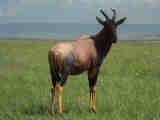
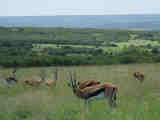
Topi; Thomson's gazelles ("Tommies")
In the evening, just after sunset, a thunderstorm passed over and gave us rain, something we actually don't need. But if we get sunshine tomorrow, the ground will dry out quickly.
We enjoyed another very beautiful day without rain. It gave me the opportunity for some more photos.
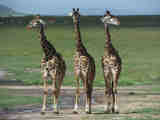
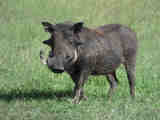
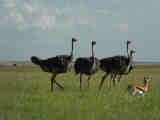
Maasai giraffes; warthog; ostriches and Thomson's gazelle
Just in case you ask, why only three photos on one day? This has two reasons. One is that I take more photos but delete all substandard ones. The other is that I do not take many photos in the first place because I know that I already have much better ones. I have become very selective. But I also know that you do not want to wade through hundreds of poor, boring photos.
There had been another rain, so some tracks have become impassable, but there were enough possibilities to get close to animals. More photos:
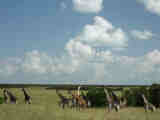

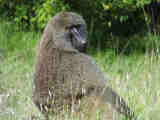
Large congregation of Maasai giraffes; wandering hippo; baboon
I saw a wandering hippo. It was all wet, so it must have just come out of the river Talek. We jokingly speculated whether this may be the hippo that causes so much noise at night and that it may have been driven out by the resident males. But indeed it turned out that the next night was much quieter. Of course it could also have been a resident male hippo that was driven out by a newcomer.
On this day I also found out that I had underestimated the size of a full-grown hippo bull. We drove to the hippo carcass and found a pride of lions, two males and four females, all adult, as well as an increasing number of other animals that wanted a share but were relentlessly chased away by the lions. Even today much of the hippo had not yet been eaten, partly beause the lions could not eat it all, but still prevented the others from eating it. Here is a collection of photos taken near the hippo carcass.
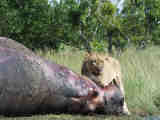
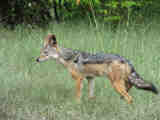
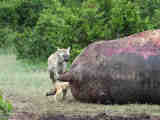
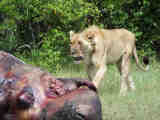
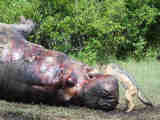
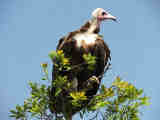
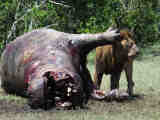
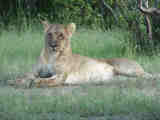
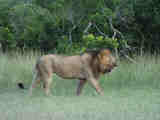
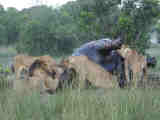
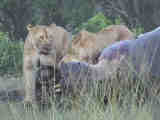
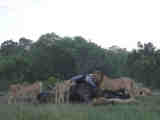
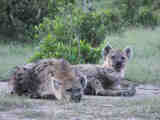
Hippo carcass, lions, silver-backed jackal, hyaenas, vulture
Finding the right position for the best photos is usually a bit difficult, but here an additional factor came into play—the almost unbearable smell on the lee side. The lions, the other predators at the carcass, and the thousand flies were obviously of a different opinion—they seemed to like it.
We woke up at 6:00, packed the things we had not packed the evening before, had breakfast at 6:30, and drove off at 7:00. Because of a thunderstorm we had seen yesterday evening in the direction of Aitong we took the same route back that we had been forced to come on—back through the nature reserve to Sekenani Gate and from there straight to Narok, Mai Mahiu, and Nairobi via the very fast Southern Bypass freeway.
The first third of the way took 5 h on gravel roads, the remaining two thirds took 3 h on tarmac (paved) roads. The road that climbs out of the Rift Valley was slow, because of slow trucks that are not allowed to take the faster highway to Nakuru.
Many cars here drive faster and make the whole distance in 5 h or less, but this is owed to the cars being bigger, particularly having bigger wheels, in the case of two-wheel-drive minibuses the superior single-wheel suspension, but also the fact that many drivers are either professionals who know the roads very well or wealthy people with big cars. Both of these do not care whether their cars occasionally break. We, however, have to try to keep the risk low, so we drive more slowly and more carefully.
The drive was uneventful. The weather was nice, sunny with a few clouds and a cool wind, so we drove most of the way with the windows open and the air conditioning off.
Eventually we arrived at the Aero Club of East Africa and moved into a nice, spacious room.
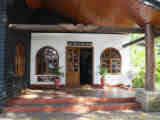
Aero Club of East Africa, club house entrance
Lots of things to do, like having the car checked, trying to obtain my renewed pilot license, etc. Not very interesting, but I had some notable or even frightening experiences.
The car hire company gave me a replacement car, a Nissan Sunny, to get around in Nairobi, while the other car underwent regular maintenance. So far, so good. I used the Nissan to get to the Kenya Civil Aviation Authority (KCAA) office at the international airport. To no avail, as they still could not find my license. Their office had been moved to a new building, and they were still in the process of unpacking the documents. So no flying this time.
I drove back to the Aero Club. We went into a nearby supermarket to do some shopping.
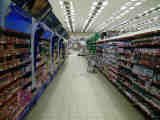
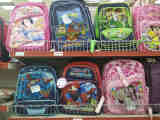
One of a dozen rows of a typical Kenyan supermarket; school backpacks
The driver of the car hire company brought us our maintained and thoroughly cleaned Suzuki Escudo and took the Nissan.
I later had to go to a place on the Mombasa Road when it was already dark. I had asked in the club whether the new Southern Bypass road that we had already used last year and this year is already drivable all the way to Mombasa Road and was assured that it is. So I drove there and, indeed, it was very good to drive, quite similar to a German four-lane freeway.
While driving over the almost empty freeway at night, it occurred to me that I should drive at reduced speed at night in Kenya, so I slowed down a little, to about 70 km/h. I was about to overtake a truck, when suddenly I saw a bunch of tons in front of me. They marked the end of my lane. There was no illumination whatsoever, not even any reflective warning sign. I guess there must have been a warning sign earlier that I had overlooked in the dark.
I had to brake and change into the remaining lane, ending up behind the truck that I wanted to overtake. This shows once again that you cannot expect anything you may take for granted in your home country when you are abroad. It also shows that driving at night is dangerous and that my decision to lower my speed had been very appropriate.
There are other dangers at night, particularly animals on the road, something that occasionally happens in Germany as well.
We had another nice breakfast in the Aero Club of East Africa, then set out for Nakuru. This would be approximately a 4-hour drive or a little shorter.
I had earlier noticed that the wheels were quite a bit out of balance and were shaking already below our top speed of 80 km/h, so I pondered the thought of having them balanced. I asked at the petrol station next to the Wilson Airport entrance and found that they had a good, modern wheel balancing machine.
Since I could have all four wheels balanced at the price of one in Germany, I decided to just do it, to be able to enjoy the drives to Nakuru and Baringo better in a smoothly rolling car.
When the wheels were taken off, the cause of the imbalance became obvious—large clumps of mud had accumulated in the rims and dried there. So the mud was removed, the wheels thoroughly washed and cleaned and, for good measure, rebalanced. They had actually been not too bad with the typical balancing weight around 25 g. The imbalance was caused by the mud in the rims. I made a mental note to make sure that the inside of the rims should be washed after driving in muddy areas.
I looked at the balancing machine and saw that it had settings for the positions of the balancing weights. In the typical aluminum rims the weights are often glued to the inside of the rims, resulting in a result that is different from weights attached to the outer edge of the rim. The machine had buttons to set the position of the weights and a nice graphical display to show them.
I noticed that the mechanic used the wrong settings on the machine. It was always set to the standard settings for weights attached to the outer edge of the rim, although they were actually glued to the inside. As a computer programmer I guessed the to me pretty obvious meaning of the buttons and showed the mechanic the proper setting for this particular type of rim. With the original setting he had needed two or three runs, adding weights iteratively. With the correct setting one run was usually enough.
He was grateful for the help. He was otherwise quite good, knew the proper sequence of tightening the wheel nuts, and did not overdo the tightening, something that is not always guaranteed.
We drove off and soon entered the Southern Bypass, which allowed us to test the result of the wheel-cleaning and balancing. It was perfect. The car rolled absolutely smoothly and no longer had any vibrations. It was more fun to drive.
Along the road we had magnificent views into the Rift Valley, particularly its lakes, Lake Naivasha and Lake Elmenteita, as the road is partly positioned higher up on the eastern side of the valley.
The rest of the way to Nakuru was uneventful. We arrived in Nakuru before 14:00 and checked into the Nuru Palace Hotel. We visited their restaurant and had a good lunch. Later we met with friends.
After an early breakfast we started towards Baringo at 8:00, because the city was about to be locked down because of a visit of the president on Madaraka (independence) Day. Even at 8:00 we got caught in one road block in the form of a yellow plastic tape across the street. It was meant more to keep cars out, rather than in, but the police man was unusually self-important and first berated us for wanting to cross the road block. Then he mumbled something about letting us out because we are visitors after we had told him that we were on our way to Baringo.
We drove on, left the city of Nakuru, and got to the last big petrol station in the area, in Mogotio. There we filled our tank and changed seats. When Mausi drove out of the station, she said that the steering does not work properly. So I sat in the driver's seat and tested it. Indeed, it was now quite stiff, but irregularly so. When I turned the steering wheel, I noticed that it was stiff for a qarter of a revolution, easy for another quarter, stiff for the next quarter, easy for the next, and so on. The stiffness always occurred at the same positions of the steering wheel, after each half revolution.
This does not necessarily have to be a dangerous defect. Most likely we could have driven the whole remaining trip with the sticky steering. But since the steering is such an important function for our security while driving and since I could not be absolutely sure that nothing would break, I decided to at least attempt a repair.
This car has an adjustable steering wheel. I looked at the steering mechanism and saw how the steering wheel connected to the control rods via two cardan joints, which were the only parts that could explain this behavior. The power steering and all other connections towards the wheels were pretty much out of the question, because they do not move in steering wheel revolution steps.
We turned back towards Nakuru and wanted to reach a big petrol station with an attached workshop along the main road that runs along the northern edge of the city. But we could not reach the main road, because access was already blocked further out because of the president's visit. So we continued along small streets on the northern side, trying to reach the main road to Nairobi on the eastern side of Nakuru. But we noticed soon that our attempts were futile and that both the main road and increasingly our small streets also were getting clogged.
At the last minute before probably getting stuck for many hours we turned back and just barely made it back to the road we had already used to leave Nakuru for Baringo.
There were four petrol stations on the edge of Nakuru, so we picked the biggest one and tried to find a car mechanic there. Indeed they knew one who worked in a little workshop across the street. He had two useful facilities for us, a pit to get under the car and a huge grease pump.
I explained the problem to him and let him do a short test drive to feel for himself what was wrong. I had already decided that the crucial action was to grease the two cardan joints, but he began to grease the lower parts of the steering and ignored the cardan joints. At least greasing the whole steering mechanism cannot hurt, I thought. After I pointed out the cardan joints to him again, he pumped an enormous amount of grease into them. I hoped that a little bit of the grease would actually reach the sticking joints.
Indeed it did. The first test drive showed that the steering was now perfectly smooth. So we paid the mechanic and happily drove on towards Baringo, passing Mogotio for the second time.
The road was good all the way to Marigat and led past my N 0°, E 36°geocache/confluence inside a huge sisal plantation. We had visited and photographed it extensively last year, so we could bypass it this year.
We reached Marigat in the early afternoon and picked up a friend who wanted to go to her family in Baringo. We also filled our tank again to be ready for the long drive to Samburu.
The deteriorating road led us deeper down into the heart of the Rift Valley. Already on the way we could overlook Lake Baringo and its islands.
As we got lower, eventually to an altitude of 3,000 ft, the temperature kept rising. We reached Roberts Camp in Baringo in the afternoon and moved into a banda (hut) with a washing basin, a flush toilet, and one big bed that filled almost the entire banda.
Baringo was as hot as ever, with a top temperature of 33°C, but still the locals maintained that this was their cool part of the year. The dry air and a little wind makes the temperature easier to bear.
We had dinner in "The Thirsty Goat", the nice little restaurant on the camp site. The other guests were two young American women.
We moved into a spacious tent, because the banda had been booked by other people who should arrive later. We liked the tent, but it has no toilet attached, so for washing, tooth-brushing, taking a shower and the toilet we had to walk over to the respective buildings. This could be problematic at night, because during the first night we had heard the hippos grazing around our sleeping place, and hippos are dangerous animals.
We met René, a Dutchman working in the tourist business, who had come here by bike, and pondered his plans to organize a bicycle tour through Kenya for paying clients. I could contribute a few bits of information about routes and places I know well.
In the late afternoon we went on a boat ride on Lake Baringo. Photos:
The skeleton of a house we had spent a night in years ago and that was now deep in the water still had a roof and was now used as a sleeping place for bats during the day.
This is a sweet water lake, so it has hippos and crocodiles. And there are many birds, over 500 species have been recorded in the area.
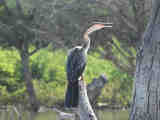
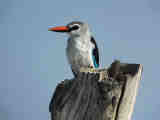
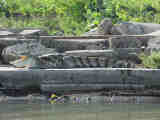

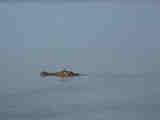
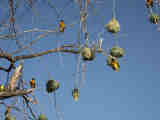
African darter; kingfisher; crocodile; black cormorant; crocodile floating;
weaver bird nesting colony
We floated by the disintegrating lodge that was damaged by high water and abandoned in 2013. It has been falling apart rapidly in the last three years, as you can see here.
Finally I took a photo of the biggest heron in existence today.
We visited friends in the evening.
We had prepared for today's long drive by going to bed early. We woke up around 5:10 and rolled out of Roberts Camp at 6:00, at the beginning of dawn. The tarmac (paved) road to Loruk was in very bad condition, but actually the road remained in very bad condition for much of the entire way.
In Loruk a new, perfect, paved road continued north towards the Sudan, but we could enjoy only a few meters of it, until we turned off to the west only a road that is actually just a car track. We would not see any paved road for the rest of the day, not counting bits that had been paved many years ago, but had meanwhile totally disintegrated.
Our route was Baringo – Loruk – Tangulbei – Churo – Mugie Ranch – Suguta lol Marmar – Kisima – Lodungokwe – passing near Wamba – Ngutuk Engiron Primary School – Samburu West Gate – Samburu Lodge.
Climbing out of the Rift Valley is always impressive. From several points we could look back on Lake Baringo from much higher up. Then we crossed the highlands to the east with many views over the beautiful hilly landscape and into deep valleys below.
A very useful surprise was that there now is a petrol station, selling unleaded super and Diesel fuel, in Suguta lol Marmar, named Suguta Filling Pump. It is locaded near the end of the town on the right side, more or less a conspicuous red "Coca Cola" container.
The woman operating the pump had to start a generator to provide electricity, because the grid had just failed, but apart from this we could easily fill our tank for KSh100 per liter, which is not too bad, given the remoteness of the place. Prices are only some 15% lower in Nairobi.
With a full tank and regularly walking around the car to check the tire pressure our only remaining problem was the remaining daylight time. We thought 10 hours would suffice, but as we progressed, we noticed that we would actually use the entire day to reach our destination.
The latter part of the way led us through flat highlands, occasionally crossing rivers that only carried little water now. The river crossings were made from concrete and would be easy to cross even if there had been a moderate amount of water flowing over them, but they were all dry now.
Finally we turned into the stony and sandy bush savannah of the Samburu country, saw quite a few wild and some domesticated animals, even a few camels, and drove down to the river towards the West Gate of Samburu. There we had to pay a moderate entry fee and continued for the last hour of our way to Samburu Lodge (officially called Samburu Game Lodge, but we do not like the word game because of its hunting association).
I conclude that the road has got worse in many places, forcing us to drive very slowly. I cannot be entirely sure whether some of the additional time was needed only because we drove more carefully than in past years, but it does not seem likely. We were now using a bigger car with better suspension than in the past, when we covered this distance in a Suzuki Maruti Gypsy.
Samburu Lodge is still our clear favorite here. Its location on the river bank and its amenities make it a very good choice. We moved into a spacious cabin of our choice, with a nice bathroom including a shower and with three big beds, of which we only needed two. A very nice candle light dinner rounded out the day.
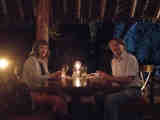
Run-in selfie of our candle-light dinner in the open-air dining room of the Samburu Lodge
It took us the morning to recover from yesterday's long drive. But when I got out in the morning and looked across the river, my first thought was, this is a paradise.
The impression continued during breakfast, because the open-air dining room let us look at the river and beyond right from our table.
In the late afternoon I drove out to get some first impressions of Samburu.
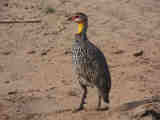
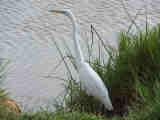
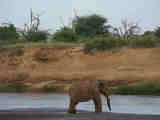
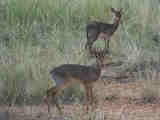
Yellow-necked spurfowl; white crane; elephant; dikdik pair
I spent the morning to make this travel report catch up with real-time, so I drove out only in the late afternoon. We saw a lioness with cubs, but they were so well hidden in bushes that I could not take any meaningful photograph. Still there are two photos from this afternoon:
We enjoyed the quiet nights, the good food, and the magnificent views of landscape and wildlife.
In the morning we got a request to look for the carcass of a pregnant giraffe that had died a few days ago in Buffalo Springs on the other side of the river, so we went there and found the place with the help of one person from the Save the Elephants organization. Except for minimal pieces of intestines, stomach content, and traces and smells nothing was left of the giraffe, no skin, no bones, nothing. Traces around the place, particularly two parts of a thorn bush cut off with sharp knives, betrayed that people had taken the giraffe carcass to eat it.
At least they had apparently not killed the giraffe—it had died of a natural cause. Our guide had seen it when it was still there and surmised that it had stumbled over a branch into a ditch and came to rest with the head down in a position where it could not quickly get up on its feet again. A giraffe can survive a head-down position only for a couple of seconds, until the blood pressure in the head rises to brain-damaging levels. It had been bleeding from the nose when our guide first saw it, which supports this hypothesis.
We went on for a little drive back on the Samburu side, up into the hills, and saw these Oryx antelopes:
Back into the lodge and ready for lunch, we saw quite a few elephants coming to the other side of the river to bathe and drink. So we postponed lunch and watched elephants instead, walking along the river in the lodge compound.
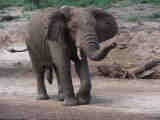
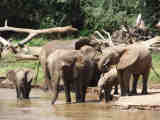
Elephant bull; elephants bathing and drinking
In the evening we drove out again and met a sizable group of giraffes, so we took documentary photos and the GPS location for the Reticulated Giraffe Project.
Later we met this family of dikdiks:
We spent time in two research projects, ewasolions.org and reticulatedgiraffeproject.net. In between we moved through the Samburu nature reserve and took more photos:
One early morning I found a male and a female ostrich (female not photographed) and took some photos, when I noticed that between some bushes there were 5 ostrich chicks sleeping, huddled together in one big lump. They slowly woke up and started to move. I had never seen ostrich chicks like this.
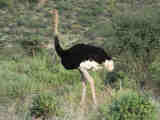

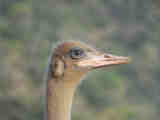
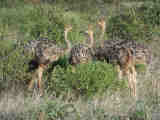
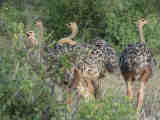
Male somali ostrich with 5 chicks
I also had the opportunity to photograph more of the shy gerenuks.
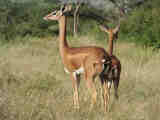
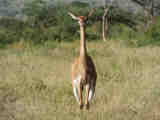
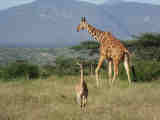
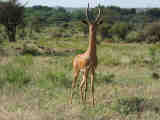
Gerenuk mother and child; gerenuk female; gerenuk with giraffe; gerenuk male
We found lions one morning and found the same ones again in the afternoon.
Photos from another drive:
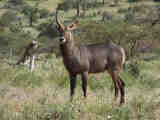
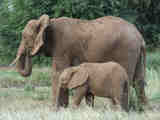
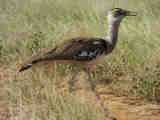
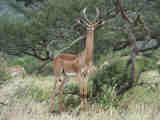
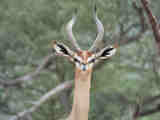
Waterbuck; elephant mother with child; Cory bustard; male gerenuk; gerenuk
close-up
You need some luck to see a leopard, but we had it this time.
And we kept seeing elephants bathing and drinking in the river, not to mention the crocodiles.
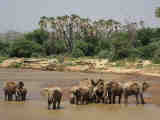
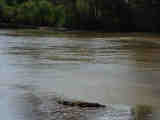
Elephants and crocodiles in Samburu River
On one of our last days we finally met the elusive Grevy zebra.
Impala bucks came back from the river after drinking.
We got up at 6:00 and had breakfast at 6:30, because we wanted to be back in Nairobi early. We had to return the car by 17:00 anyway. At 7:20 we drove out of the lodge after saying our goodbyes.
Because of an undefined problem in Buffalo Springs, according to rumor some thieves fleeing with stolen camels and their pursuers, and a related gunshot we had heard two days ago on the other side of the river, we decided not to drive through Buffalo springs, but instead to drive to Archer's Post instead. The way is a bit longer, but not slower, because we could use more of the new, excellent, and fast Isiolo road. We may have been overly cautious here, because it was very unlikely that the problem persisted for days and equally unlikely that anybody would shoot at a tourist car inside a nature reserve, attracting dire consequences. But we thought that we would avoid even the tiniest risk if that was so easy.
The drive was uneventful. We stopped at Barney's Bar & Restaurant on Nanyuki Civil Aerodrome for another late breakfast or early lunch. The food was tasty and excellent as always.
Then we drove on and reached the fast Thika freeway, leading us right into Nairobi at high speed. We reached Concorde Car Hire after 8:15 hours, including the 45-minute stop at Barney's, so it was 7:30 hours of driving for a distance of 331 km, yielding an average speed of 44 km/h.
We returned the car after driving approximately 2,550 km in it. We had thus stayed within the 2,700 km allowance, mainly because we had skipped the trip to Amboseli, which would have taken us well beyond 3,000 km in total. But the excess kilometers would not have been too expensive either, so the cost was not a serious issue for us.
A driver took us to the Aero Club of East Africa. On this Saturday the traffic was only moderately dense, so we could cross Nairobi in half an hour, rather than the two hours often needed during the rush hours.
We talked to some friends on the airport, then went to bed early.
The alarm clock (in the smartphone) was set for 4:00, the taxi was ordered for 5:00, we were ready before that, and the taxi came early also. The drive to the airport (JKIA—Jomo Kenyatta International Airport) took about half an hour, and so we were there before most passengers of our flight. The check-in, or rather, baggage drop, and the immigration counter took little time, and so we were ready to fly already 2 hours before departure. This may sound like a waste of time, but in Africa there are always incalculable risks. An accident might have caused a traffic jam and stopped us on the road, for example. We used the time to communicate and read the news.
The plane was a Boeing 787-8 "Dreamliner", the same type, perhaps even the same plane, we had come in. As described in the beginning, the GPS does not work at all in this plane, so there is no GPS track of this flight either. After boarding and waiting half an hour for a baggage sorter problem to be solved, we took off into the morning sun.
We had nice seats behind the wings at the window and could see some Kenyan landmarks, like Mt. Kenya, from the air. But for some of the way it was cloudy, so we watched movies on the very good entertainment system. Very good for me, because as a computer programmer I could find out how to operate it. I must say that for an average, not-computer-oriented person the system had a good deal of traps and was not easy enough to operate, in my view. But for us it was OK. There were two tasty, hot meals.
The flight progressed nicely, along the river Nile, across the Mediterranean Sea, along the Albanian coast, past Munich, to Amsterdam. We arrived there approximately on time, accelerated by the favorable Passat winds in Africa, and had enough time to write messages, using the airport's free and fast Wi-Fi, and find the gate to our next plane, a Boeing 737 to Munich.
That flight was also uneventful. We could see the ground only during takeoff and landing and in very few other places along our route, as there were at least two cloud layers in most places. We landed in light rain. Our eldest son had come to collect us. I took to the wheel of my car to get used to German driving again, particularly to driving on the right side of the road and to driving faster than we could during the last 4 weeks. There are very few bits of road in Kenya where you can safely drive faster than 80 km/h.
Another visit to Kenya has come to an end. Kenya was as fascinating as ever.
If in this text you find any typos, orthographic errors (even small ones), ungrammatical sentences, wrong or illogical information (like wrong names of birds), if you want me to write more details about something in particular, or if you want one of the photos in full resolution, please click on the email sign below and write to me. Many thanks!
Copyright © 2016-2023 Hans-Georg Michna.
Private homepage – Hans-Georg Michna
Kenya travel reports: 1999, 2000, 2002, 2003, 2004, 2005, 2006, 2007, 2008, 2009, 2010, 2011, 2012, 2013-Goma, 2013, 2014, 2015, 2016, 2017, 2018, 2019
Kenya Safari Travel Plan, Kenya 1980-2000 photos
hits since 2016-02-20
Free PHP scripts by PHPJunkYard.com